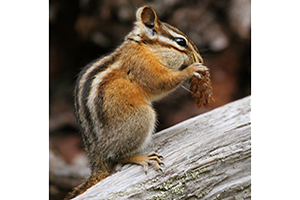Among the squirrels, there is a link between brain size and amount of time spent above ground in vegetation; an animal that spends more time in trees and shrubs tends to have a larger brain. Where the least chipmunk is found with other chipmunks, it has a smaller brain and spends less time off the ground.
Photo Credit: Phil Myers
Tamias minimus
Common Name: least chipmunk
Other Scientific Names: Eutamias minimus, Neotamias minimus
Animal Guild: Mammal
Class > Order > Family: Mammalia > Rodentia > Sciuridae
What does the species look like?
Chipmunks are among the more difficult rodents to identify without handling or making skeletal measurements. In the least chipmunk, the stripes on the face and sides usually are conspicuous, but overall color varies. For example, some populations are characterized by reddish or orange tones on the sides, whereas in dry regions the sides are much paler and grayish. In accordance with its name, the least chipmunk is on average the smallest chipmunk in North America, but its size overlaps with other species. The least chipmunk generally holds its tail straight up when running, in contrast to the yellow pine chipmunk, which holds the tail more horizontally or angled only slightly upward.
Where is the species found?
States & Provinces
AB, AZ, BC, CA, CO, ID, MB, MI, MN, MT, ND, NE, NM, NT, NV, ON, OR, QC, SD, SK, UT, WA, WI, WY, YT
Distribution
The range extends from central Yukon to Ontario (Canada), Michigan, and northern Wisconsin; it also includes the western Great Plains, Rocky Mountains, Cascades, Olympic Mountains, and the Sierra Nevada.
The least chipmunk is found in a wide range of habitat types across its large range. The common element is that all are relatively open near ground level. The overstory may be relatively dense woodland (although open enough that the ground will be sunlit), shrubland, or open meadow. The yellow-pine chipmunk (Neotamias amoenus) is found in some of the same geographic area but usually occurs in areas with denser ground-level vegetation.
General Phenology and Life History
Least chipmunks exhibit variable periods of dormancy in winter. Winter inactivity in longer in the north and at higher elevations than elsewhere. Chipmunks periodically awaken in winter to feed on stored food. They may be active above ground at any time when weather is relatively warm. Breeding commences soon after emergence from winter dormancy. In Colorado, most breeding occurs probably from late March to early July. Females produce litters of 3-8 young in spring or summer (timing varies with location). Young emerge from their natal burrows at about one month of age.
Which phenophases should I observe?
Do you see/hear...?
Activity
Live individuals More...
For abundance, enter the number of individual animals observed in this phenophase.
Feeding For abundance, enter the number of individual animals observed in this phenophase.
Fruit/seed consumption For abundance, enter the number of individual animals observed in this phenophase.
Nut gathering For abundance, enter the number of individual animals observed in this phenophase.
Development
Young individuals For abundance, enter the number of individual animals observed in this phenophase.
Dead individuals For abundance, enter the number of individual animals observed in this phenophase.
What do these phenophases look like?
There is currently no photoguide available for this species. If you'd like help us create one, use the guidance document and species template provided here . Then send it via email to education@usanpn.org when it is complete.
